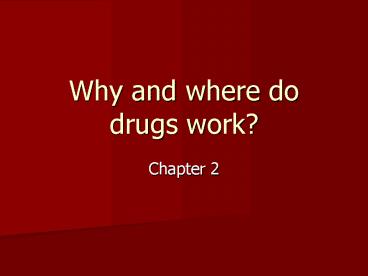Why and where do drugs work - PowerPoint PPT Presentation
1 / 22
Title:
Why and where do drugs work
Description:
... is inversely proportional to the distance between the two charged groups ... The strength of the interaction decreases with distance more quickly than with ... – PowerPoint PPT presentation
Number of Views:19
Avg rating:3.0/5.0
Title: Why and where do drugs work
1
Why and where do drugs work?
- Chapter 2
2
Why do drugs work?
- Drugs are chemicals
- Interact with the bodys chemicals
- How/where will they interact?
- - Binding through intermolecular forces
3
Drug Targets
- Drug targets are large molecules - macromolecules
- Drugs are generally much smaller than their
targets - Drugs interact with their targets by binding to
binding sites - Binding sites are typically hydrophobic pockets
on the surface of macromolecules - Binding interactions typically involve
intermolecular bonds - Functional groups on the drug are involved in
binding interactions and are called binding
groups - Specific regions within the binding site that are
involved in binding interactions are called
binding regions - Most drugs are in equilibrium between being bound
and unbound to their target
4
Unbound drug
5
Electrostatic or ionic bond
- Strongest of the intermolecular bonds (20-40 kJ
mol-1) - Takes place between groups of opposite charge
- The strength of the ionic interaction is
inversely proportional to the distance between
the two charged groups - Stronger interactions occur in hydrophobic
environments - Ionic bonds are the most important initial
interactions as a drug enters the binding site
6
Hydrogen Bonds
- Vary in strength
- Weaker than electrostatic interactions but
stronger than other IFs - A hydrogen bond takes place between an electron
deficient hydrogen and an electron rich
heteroatom (N or O) - The electron deficient hydrogen is attached to a
heteroatom (O or N) - The electron deficient hydrogen is called a
hydrogen bond donor - The electron rich heteroatom is called a hydrogen
bond acceptor
7
Hydrogen Bonds
- The interaction involves orbitals and is
directional - Optimum orientation is where the X-H bond points
directly to the lone pair on Y such that the
angle between X, H and Y is 180o
8
Hydrogen Bonds
- Examples of strong hydrogen bond acceptors
- - carboxylate ion, phosphate ion, tertiary amine
- Examples of moderate hydrogen bond acceptors
- - carboxylic acid, amide oxygen, ketone, ester,
ether, alcohol - Examples of poor hydrogen bond acceptors
- - sulfur, fluorine, chlorine, aromatic ring,
amide nitrogen, aromatic amine - Example of good hydrogen bond donors
- - Quaternary ammonium ion
9
Van der Waals Interactions
- Very weak interactions (2-4 kJmol-1)
- Occur between hydrophobic regions of the drug and
the target - Due to transient areas of high and low electron
densities leading to temporary dipoles - Interactions drop off rapidly with distance
- Drug must be close to the binding region for
interactions to occur - The overall contribution of van der Waals
interactions can be crucial to binding
DRUG
10
Dipole-dipole interactions
- Can occur if the drug and the binding site have
dipole moments - Dipoles align with each other as the drug enters
the binding site - Dipole alignment orientates the molecule in the
binding site - The strength of the interaction decreases with
distance more quickly than with electrostatic
interactions, but less quickly than with van der
Waals interactions
11
Dipole-dipole interactions
12
Ion-dipole interactions
- Occur where the charge on one molecule interacts
with the dipole moment of another - Stronger than a dipole-dipole interaction
- Strength of interaction falls off less rapidly
with distance than for a dipole-dipole interaction
13
Induced-dipole interactions
- Occur where the charge on one molecule induces a
dipole on another - Occurs between a quaternary ammonium ion and an
aromatic ring
Binding site
14
Desolvation penalties
- Polar regions of a drug and its target are
solvated prior to interaction - Desolvation is necessary and requires energy
- The energy gained by drug-target interactions
must be greater than the energy required for
desolvation
O
H
O
H
O
H
Binding site
Binding site
Binding site
Binding - Energy gain
Desolvation - Energy penalty
15
Hydrophobic interactions
- Hydrophobic regions of a drug and its target are
not solvated - Water molecules interact with each other and form
an ordered layer next to hydrophobic regions -
negative entropy - Interactions between the hydrophobic interactions
of a drug and its target free up the ordered
water molecules - Results in an increase in entropy
- Beneficial to binding energy
Unstructured water Increase in entropy
Structured water layer round hydrophobic regions
16
Where do drugs interact?
- Cells
- Four main targets
- Lipids
- Carbohydrates
- Nucleic acids
- Proteins
17
I. Lipids
- What is a lipid?
- Polar head (hydrophilic)
- Nonpolar tail (hydrophobic)
- Where are lipids typically located?
- ? Cell membranes of most interest
18
(No Transcript)
19
Drug interactions with lipids
- Small number of drugs
- Disrupt lipid structure and kill cell
- 1. Tunnels
- 2. Carriers/shuttles
- Amphotericin B
- Antifungal agent
- Forms hydrophilic tunnel (Fig. 2.21)
- Valinomycin
- Antibacterial agent/antibiotic
- Not selective for bacterial cell
- Shuttle hydrophilic material out of cell (K)
20
II. Carbohydrates
- Empirical formula CH2O
- Energy storage, structural
- Glucose
21
Carbohydrates as drug targets
- Used to tag cells
- Certain cells associated with certain
carbohydrates - Glycoproteins, glycosphingolipids
- Interaction of tag with drug to protect or treat
cells - More commonly carbohydrates as part of drugs
- Anti-HIV
- Antiherpes
- Antibiotics
- Recent development
- Difficult synthesis
- Varied structures
22
III. Nucleic acids
- Skip this
- IV. Proteins
- Next several chapters































